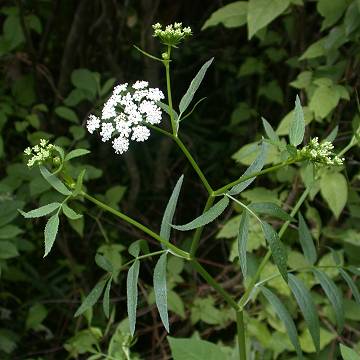

Sium suave - (image 1 of 7)
Taxonomy
Family: Apiaceae
Habitat
Marshes, ditches. Ponds, lakes, streams, meadows, swamps, tidal river shores, and floodplain forests.
Associates
Distribution
Newfoundland west to AK and Siberia, south FL to CA.
Morphology
Herbaceous, aquatic perennial with both submersed and emersed leaves, to 2 m. Leaves compound, odd-pinnate, rarely simple, serrate, long-petioled, to 10" long; leaflets toothed, the basal ones often submerged and finely cut (image 6). Flowers in twice-compound umbels; petals white. Fruit an ovoid schizocarp, slightly compressed laterally, with prominent corky winged ribs.
Notes
Flowers mid July to mid September
Wetland indicator: Obligate
Although the roots of this plant are reputed to be edible, its resemblance to Water Hemlock (Cicuta maculata) makes this a dangerous proposition. It is generally wise to leave all aquatic members of this family alone. Additionally, the poison hemlock of antiquity, Conium maculatum L., has naturalized widely in the U.S. and has similar flowers but more finely dissected leaves; it occurs as a weed in moist to dry, disturbed habitats.
References
Crow, Garrett E and C. Barre Hellquist. 2000. Aquatic and Wetland Plants of
Northeastern North America
Vol. 1. Pteridophytes, Gymnosperms, and Angiosperms: Dicotyledons
The University of Wisconsin Press. Madison, WI
Gleason, Henry A. and A. Cronquist. 1991. Manual of Vascular Plants of Northeastern United States and Adjacent Canada. Second Ed.
The New York Botanical Garden. Bronx, NY
Niering, W. A. 1979. The Audubon society field guide to North American
wildflowers: eastern region.
Knopf/Random House, New York.
Swink, F. and G. Wilhelm. 1994. Plants of the Chicago Region.
Indiana Academy of Science. The Morton Arboretum. Lisle, Illinois.
|
Michael Hough © 2005 |